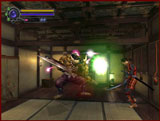 Talk about a killer application.
Genma Onimusha is one of the deadliest games around, one that will kill you so often that
you’ll find yourself pacing the floor with frustration--an unpleasant feel of heart
strain oozing from every pore, as the words "Died" float eerily across your TV.
When the original Onimusha: Warlords was released on the Playstation 2 in 2001, the game
received only two major complaints; it was too short, and it was too easy. When the Xbox
release rolled around, Capcom proudly announced it had fixed both problems, packaged an
improved version of the highly acclaimed game into a pretty little box, and threw it out
onto the shelves for the world to gawk at. True to the claim, Onimusha is both longer and
more difficult, with the enemies packing an extra wallop, and the save points so far apart
that every death entails at least ten minutes worth of recovering lost territory. There is
no doubt that Onimusha will take more time to complete than in the past, but it
accomplishes this by slowing down your progress more than expanding the size of the game
itself. By the time the final credits hit the screen, there won’t be a piece of the
game you haven't played at least three times over--most of it with gritted teeth.
Talk about a killer application.
Genma Onimusha is one of the deadliest games around, one that will kill you so often that
you’ll find yourself pacing the floor with frustration--an unpleasant feel of heart
strain oozing from every pore, as the words "Died" float eerily across your TV.
When the original Onimusha: Warlords was released on the Playstation 2 in 2001, the game
received only two major complaints; it was too short, and it was too easy. When the Xbox
release rolled around, Capcom proudly announced it had fixed both problems, packaged an
improved version of the highly acclaimed game into a pretty little box, and threw it out
onto the shelves for the world to gawk at. True to the claim, Onimusha is both longer and
more difficult, with the enemies packing an extra wallop, and the save points so far apart
that every death entails at least ten minutes worth of recovering lost territory. There is
no doubt that Onimusha will take more time to complete than in the past, but it
accomplishes this by slowing down your progress more than expanding the size of the game
itself. By the time the final credits hit the screen, there won’t be a piece of the
game you haven't played at least three times over--most of it with gritted teeth. 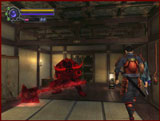 That said,
Genma Onimusha is a very good game. Its strong atmosphere and game play, its numerous
zombies and blood splats, and its top notch graphic look guarantee that the four little
stars rotating at the top of the screen are not a mistake. The first paragraph simply
stands as a warning, sort of like the type people ignore on the side of cigaret cartons,
that Genma Onimusha, a strong contender in the genera started and defined by Resident
Evil, is not for the weak of heart. Literally. Heart attacks may occur. Don’t say I
didn’t warn you.
That said,
Genma Onimusha is a very good game. Its strong atmosphere and game play, its numerous
zombies and blood splats, and its top notch graphic look guarantee that the four little
stars rotating at the top of the screen are not a mistake. The first paragraph simply
stands as a warning, sort of like the type people ignore on the side of cigaret cartons,
that Genma Onimusha, a strong contender in the genera started and defined by Resident
Evil, is not for the weak of heart. Literally. Heart attacks may occur. Don’t say I
didn’t warn you.
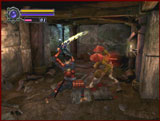 The
story behind Onimusha is relatively straight forward, though not without its own dark
additions for originality. You are a warrior trying to save your princess from the jaws of
an evil demon ceremony. This is done by hacking your way through loads of evil spirits,
absorbing their souls for health, magic power, and points—all with a magical blinking
gauntlet given to you by a clan of ogres. The world is composed of beautifully
pre-rendered backgrounds, and navigated through the use of fixed camera angles that
automatically switch as you make your way through the game. As you play, you’ll
stumble upon various journals, papers, and parchments describing the back story, or parts
of it, through the eyes of a man quickly slipping into insanity, allowing for action
taking place in the present to be flushed out with cinematic cut-scenes. While nothing
really new, the story is atmospheric, at times creepy (especially when being stalked by
that vampire doll that took me forever to figure out how to kill), and fits well with the
style of the game.
The
story behind Onimusha is relatively straight forward, though not without its own dark
additions for originality. You are a warrior trying to save your princess from the jaws of
an evil demon ceremony. This is done by hacking your way through loads of evil spirits,
absorbing their souls for health, magic power, and points—all with a magical blinking
gauntlet given to you by a clan of ogres. The world is composed of beautifully
pre-rendered backgrounds, and navigated through the use of fixed camera angles that
automatically switch as you make your way through the game. As you play, you’ll
stumble upon various journals, papers, and parchments describing the back story, or parts
of it, through the eyes of a man quickly slipping into insanity, allowing for action
taking place in the present to be flushed out with cinematic cut-scenes. While nothing
really new, the story is atmospheric, at times creepy (especially when being stalked by
that vampire doll that took me forever to figure out how to kill), and fits well with the
style of the game.
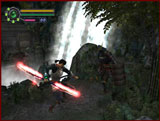 While
a horror-survival game at its heart, Onimusha sprinkles the story with puzzles, and keeps
combat interesting with the ability to find and upgrade your weapons throughout the game.
Whenever an enemy is slain, his conveniently self cleaning corpse releases up to four
colored orbs which Samanosuke (you) absorbs to gain certain bonuses, including health, and
power for magical attacks. Additionally, Onishuma has a green orb that can be absorbed to
give Samansuke temporary invincibility, accompanied by a revitalizing effect on your
health. These green orbs can also be absorbed by enemies, which will then become more
feisty, aggressive, and over all more difficult combatants. This is a change from the PS2
version, and leads to a rather substantial difference in game play, since you often have
to enter tug of wars with various enemies over the souls, or face an army of red super
demons where before there were none. Though health orbs are few and far between, leading
to an almost always injured Samanosuke, the absorption of souls plays an important and
interesting role in the game.
While
a horror-survival game at its heart, Onimusha sprinkles the story with puzzles, and keeps
combat interesting with the ability to find and upgrade your weapons throughout the game.
Whenever an enemy is slain, his conveniently self cleaning corpse releases up to four
colored orbs which Samanosuke (you) absorbs to gain certain bonuses, including health, and
power for magical attacks. Additionally, Onishuma has a green orb that can be absorbed to
give Samansuke temporary invincibility, accompanied by a revitalizing effect on your
health. These green orbs can also be absorbed by enemies, which will then become more
feisty, aggressive, and over all more difficult combatants. This is a change from the PS2
version, and leads to a rather substantial difference in game play, since you often have
to enter tug of wars with various enemies over the souls, or face an army of red super
demons where before there were none. Though health orbs are few and far between, leading
to an almost always injured Samanosuke, the absorption of souls plays an important and
interesting role in the game.
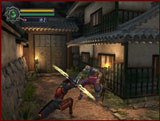 The
controls could stand some improving, though one gets used to them after a while. Movement
is controlled entirely through the directional control pad -- pushing up will always move
you forward in the direction you are facing, left and right rotate you -- and will feel
awkward and cumbersome to players who are used to playing with the Xbox Analog sticks.
This is because, quite frankly, it is awkward and cumbersome. Even after
you’ve been playing for a while, moving across rooms will be done in a sort of zigzag
pattern as you attempt to line your character up with a door or chest. It baffles me that
Capcom didn’t include the ability to re-map any controls besides the four fighting
buttons, and virtually ignores the analog sticks all together, used instead to access your
inventory and maps. This is particularly annoying when some large monster looms so
completely in front of the camera that you can no longer see which direction you are
swinging, facing, or chopping. This is partially alleviated by the auto-targeting system
that swings your character around to face the nearest enemy, unless you’re facing the
entirely wrong direction, but there isn’t any reason for the problem to have existed
at all.
The
controls could stand some improving, though one gets used to them after a while. Movement
is controlled entirely through the directional control pad -- pushing up will always move
you forward in the direction you are facing, left and right rotate you -- and will feel
awkward and cumbersome to players who are used to playing with the Xbox Analog sticks.
This is because, quite frankly, it is awkward and cumbersome. Even after
you’ve been playing for a while, moving across rooms will be done in a sort of zigzag
pattern as you attempt to line your character up with a door or chest. It baffles me that
Capcom didn’t include the ability to re-map any controls besides the four fighting
buttons, and virtually ignores the analog sticks all together, used instead to access your
inventory and maps. This is particularly annoying when some large monster looms so
completely in front of the camera that you can no longer see which direction you are
swinging, facing, or chopping. This is partially alleviated by the auto-targeting system
that swings your character around to face the nearest enemy, unless you’re facing the
entirely wrong direction, but there isn’t any reason for the problem to have existed
at all.
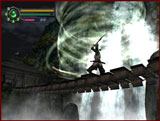 That
is, for the most part, the only complaint I have about the camera. Though in large the
system does a good job of allowing the player to see, there are times when the
preprogrammed camera angle shifts are disorienting, and can lead to confusion and
difficulty in combat. Few things are as frustrating as being hacked to death by a monster
standing just out of the visual range of your camera. Still, there is no doubt in my mind
that equally annoying problems would have existed had a free floating, real-time rendered
environment been used, and I’m very glad it wasn’t. The pre-rendered images are
simply beautiful.
That
is, for the most part, the only complaint I have about the camera. Though in large the
system does a good job of allowing the player to see, there are times when the
preprogrammed camera angle shifts are disorienting, and can lead to confusion and
difficulty in combat. Few things are as frustrating as being hacked to death by a monster
standing just out of the visual range of your camera. Still, there is no doubt in my mind
that equally annoying problems would have existed had a free floating, real-time rendered
environment been used, and I’m very glad it wasn’t. The pre-rendered images are
simply beautiful.
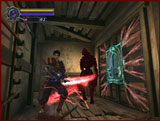 In
fact, the world is so visually detailed that it is easy to miss important clues amongst
the clutter of the books, shelves, and wall decorations, since certain objects won’t
react to you unless you’re facing them just right. And I’m not talking about
just little things like books and chests, but entire doors sometimes get lost amongst the
shifting angles and cluttered background.
In
fact, the world is so visually detailed that it is easy to miss important clues amongst
the clutter of the books, shelves, and wall decorations, since certain objects won’t
react to you unless you’re facing them just right. And I’m not talking about
just little things like books and chests, but entire doors sometimes get lost amongst the
shifting angles and cluttered background.
I think there are one or two doors I may never have seen if it weren't for the maps
that you pick up along the way. Sometimes, wandering around lost is a result of missing
something that’s supposed to be obvious.
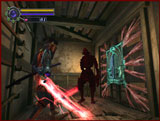 At
the start of the game, before you improve your weapons skills, save points are spaced too
far apart. A good example of non-combat problems due to lack of save points is a series of
puzzles midway through the game, three of them, just after a save point. The first two
puzzles are easy but time consuming, while the third is much more difficult and time
limited. When the clock strikes zero, you find yourself at the gate prier to unlocking the
first puzzle. It only takes a few deaths in this manner to grow very tired of repeating
the same sequences over and over, just to return to a place where you have a chance to
progress the game. The developers also have a tendency to place very difficult obstacles
one after another with no save points in-between, so that you spend twenty lives battling
some combination of monsters, finally defeat them, only to find yourself with another set
only three scenes down the road while in the midst of celebrating. It leads to the catch
motto: Real warriors save. An easy mode unlocks after you die the dozenth time or so, but
even then you’ll have problems. If I were rich and had controllers to spare, I’d
have thrown at least two of them through the window. For this reason, it will, at moments,
rank as one of the stupidest and worst designed games you have ever played . . . at least
until you make it to the next cut-scene and forget all the names you called it before. My
recommendation is to keep certain game sessions down to thirty minutes at a time, just to
protect the functionality of your gaming hardware. Luckily, this problem becomes less
distinct as you progress farther into the game and you become more capable of defending
yourself against the forces of darkness, though it still rears it ugly head from time to
time.
At
the start of the game, before you improve your weapons skills, save points are spaced too
far apart. A good example of non-combat problems due to lack of save points is a series of
puzzles midway through the game, three of them, just after a save point. The first two
puzzles are easy but time consuming, while the third is much more difficult and time
limited. When the clock strikes zero, you find yourself at the gate prier to unlocking the
first puzzle. It only takes a few deaths in this manner to grow very tired of repeating
the same sequences over and over, just to return to a place where you have a chance to
progress the game. The developers also have a tendency to place very difficult obstacles
one after another with no save points in-between, so that you spend twenty lives battling
some combination of monsters, finally defeat them, only to find yourself with another set
only three scenes down the road while in the midst of celebrating. It leads to the catch
motto: Real warriors save. An easy mode unlocks after you die the dozenth time or so, but
even then you’ll have problems. If I were rich and had controllers to spare, I’d
have thrown at least two of them through the window. For this reason, it will, at moments,
rank as one of the stupidest and worst designed games you have ever played . . . at least
until you make it to the next cut-scene and forget all the names you called it before. My
recommendation is to keep certain game sessions down to thirty minutes at a time, just to
protect the functionality of your gaming hardware. Luckily, this problem becomes less
distinct as you progress farther into the game and you become more capable of defending
yourself against the forces of darkness, though it still rears it ugly head from time to
time.
Capcom extended Onimusha’s length, but it could still be considered short. Though
the numerous deaths and reloads slowed me down, this game could easily be beaten in a
single intense rental session. While it doesn't say it in the documentation, online
sources suggest that you can unlock the difficult mode by beating the game in under three
hours, suggesting that at some point the programers thought it possible, if not likely,
for such a task to be done in such a short period of time. A linear game such as this that
can be played in less than three hours still qualifies as a short game, though it will
probably take you double that your first time through.
Voice dubbing is adequate, complete with the classic "still moving mouth long
after done talking" effect that bless so many good martial arts films not originally
filmed in English. Better yet, the game allows you to turn on the native dialog with
English sub-captions. It was nice to see audio and video sync for a change, and it was a
neat added feature.
Ultimately, Genma Onimusha is one of the better games that I’ve played, even
though it can be at times down right infuriating, and promotes homicidal tendencies (both
in graphics and psychological affects). With an interesting, if not original, story line,
good graphics, and entertaining combat and weapons, Onimusha is a must rent for any fan of
action/adventure/ survival games. Unfortunately, with such a limited replay value and
short story length, not to mention the frustrating difficulty level, I find that the game
qualifies on the low end of the four star spectrum, enough that I wouldn’t recommend
a purchase without a good six hours bathed in the red glow of a rental. If you still
decide to buy it, there are far worse games on the market, and if you’re looking to
purchase sight unseen, most players would be safe with this one. It is simply a good game.
